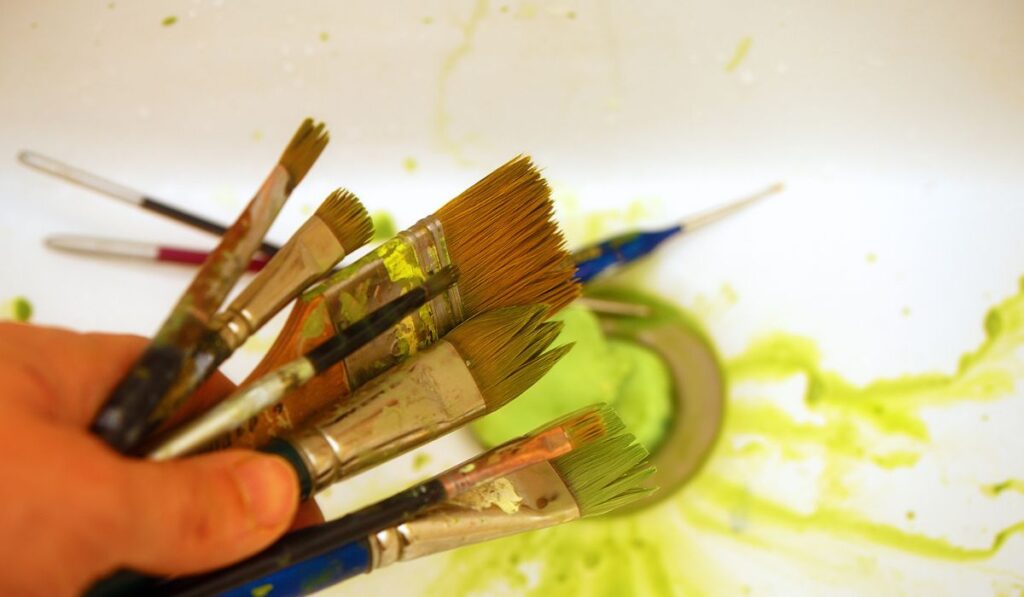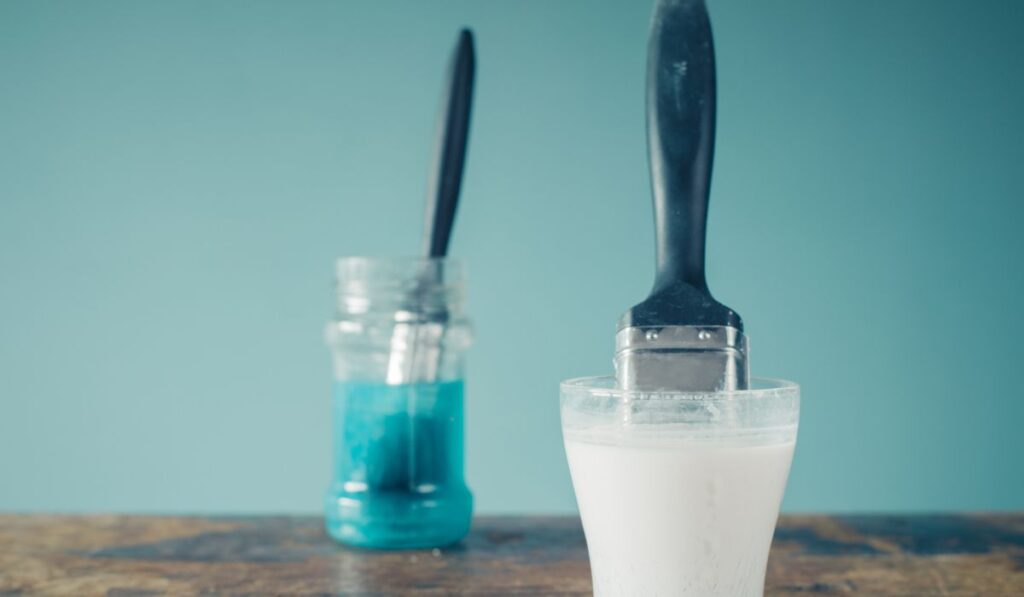If you love art, you know what your paintbrushes mean. They are the most essential tools you have, aside from the roller. But, to produce high-quality art, paintbrushes must be kept clean.
No, it’s not okay to clean paint brushes in the sink. Paints, except for natural paints, contain harmful chemicals, so washing paint brushes in your sink can lead to environmental pollution. Additionally, it may cause harm to your health if it comes in contact with your dishes.
Read on to find out why you can’t wash your brushes in the sink and how you can safely wash your paint brushes.
Is it Okay to Clean Paint Brushes in the Sink?

Washing your paint brushes immediately after finishing a project can save you a lot of money. It’s tempting to rush to the sink to clean your brushes in the sink, but this is not recommended.
Septic Damage
Septic systems and paint should not be allowed to mix. Even just a tiny amount of paint can cause severe damage to the septic system.
There are many chemicals in the binding part of a paint that helps it to bind to surfaces. These chemicals help the paint protect surfaces against abrasions or moisture. The binder in most paints is a polymer or plastic, meaning they are non-biodegradable.
When paint gets into your septic system, pipes, and tank, and even in the drain field, its particles will bind to all these surfaces as it moves. This will eventually obstruct the pipes as it builds up.
Paint can cause significant problems in the entire septic system because it can interfere with the bacteria that break down organic materials.
Environmental Damage
Secondly, when paint gets into a septic tank, it will likely end up in the drain field. From there, there’s a high probability that it will get into the affluent areas, where it will stay for some time. This will pollute groundwater and well water.
How to Clean Paint Brushes Properly
The method you choose to clean your paint brushes depends on the paint used. Even if the paint is oil-based, you can’t simply store the brushes without washing them.
Natural Paints
Natural paints are made from milk protein, clay, minerals, and plants, meaning they are biodegradable and non-toxic. As a result, these paints don’t contain harmful chemicals, provided no other chemical-based, or metallic dyes are added.
If you’ve used natural paint, you can rinse the brushes in your sink or bucket. The water used to clean them can also be poured down the drain or on the ground.
Latex Paints
Latex paints are also safe but not as safe as natural paints because they contain harmful chemicals, including VOC. After using latex paint, wear gloves and squeeze as much paint from the brush as possible. Use dry newspaper to remove excess paint, then rinse the brush using warm soapy water.
If your house is connected to a municipal sewer system, you can wash your latex paint brush directly in your sink. If using a septic tank, wash the brush in a bucket but don’t pour the water away. Instead, let it sit outside to evaporate until it dries. You can discard the dried paint with other household trash.
Oil Paints
Oil-based paints require extra care because they are harmful to the environment. The solvents needed to clean them may also produce toxic fumes, so you need to do your cleaning in a well-ventilated room or outdoors. Use the steps below to clean your oil-based paintbrush.
- Wear hand gloves, then lay down a piece of cloth on the floor to protect it from the paint.
- Use a wire paint comb to remove the brush as much paint as possible.
- Fill a small clean can with a non-toxic solvent and soak the brushes. Let the brush stay in the solvent for about five minutes. Swirls, then brush before removing them and removing the loose paint.
- Use a newspaper or paper towel to blot the solvent from the brush. Soak again and blot two to three more times, using a new can each time. You can then leave the brushes to dry. You can keep it for reuse or discard it.
- If you’ve used a water-based solvent, let the water evaporate outdoors, then discard the residual solid paint in a sealed plastic bag. If you want to reuse the solvent, let the solid paint settle for a few days, then filter the mixture using a non-food strainer or coffee filter.
How to Clean Paint Brushes Without Chemical Solvents

Some chemical solvents used to clean brushes are kerosene oil, turpentine, and thinner. These chemicals aren’t eco-friendly. To avoid using them, there are many safe household eco-friendly alternatives you can choose, including:
Vinegar
Vinegar can replace thinner. You can use white vinegar to clean your antique brush. Heat the vinegar in a microwave for about one minute, then soak the paintbrush in the hot vinegar for about 30 minutes. Finally, rinse the brush and allow it to dry.
Citrus Solvent
This solvent works in the same way as vinegar. The citrus solvent is environmentally friendly because it’s made of pure citrus peeling extract and water. You don’t even need to worry about disposing of this solvent.
Fabric Softener
Using a fabric softener and a scraper is another good way of cleaning your paint brushes.
- First, use the scraper to remove all the residual paint from the brushes before cleaning them using the fabric softener.
- Next, mix a gallon of water with 4-5 tablespoons of fabric softener and use this mixture to clean your brushes.
- Rinse the brush using warm water, then allow it to dry.
Baby Oil
You may not believe it, but baby oil is another excellent paint brush cleaner. Just put a small amount of baby oil on the bristles of your dirty brush. Then, spread the oil thoroughly to cover all the hairs on the brush. After cleaning using baby oil, wash the brush with soapy water, then rinse using clean water and allow it to dry.
Reuse Paint Rollers And Brushes
Paint rollers and brushes can be reused. There are paint rollers and brushes you can use for several painting projects. For example, a high-quality roller can be used up to five times without compromising the quality of the painting project.
All you need to do is to scrape the roller after use. After scrapping it, wrap it in an airtight wrap when still wet and store it in the fridge.
Remember that the cleaning process for your roller depends on its nature, whether a foam or nap roller and the type of paint you’ve used.
For example, latex paints like water-based acrylics or vinyl styrene stick to the nap roller so rigidly that it becomes difficult to clean. So you have to be careful when cleaning them.
